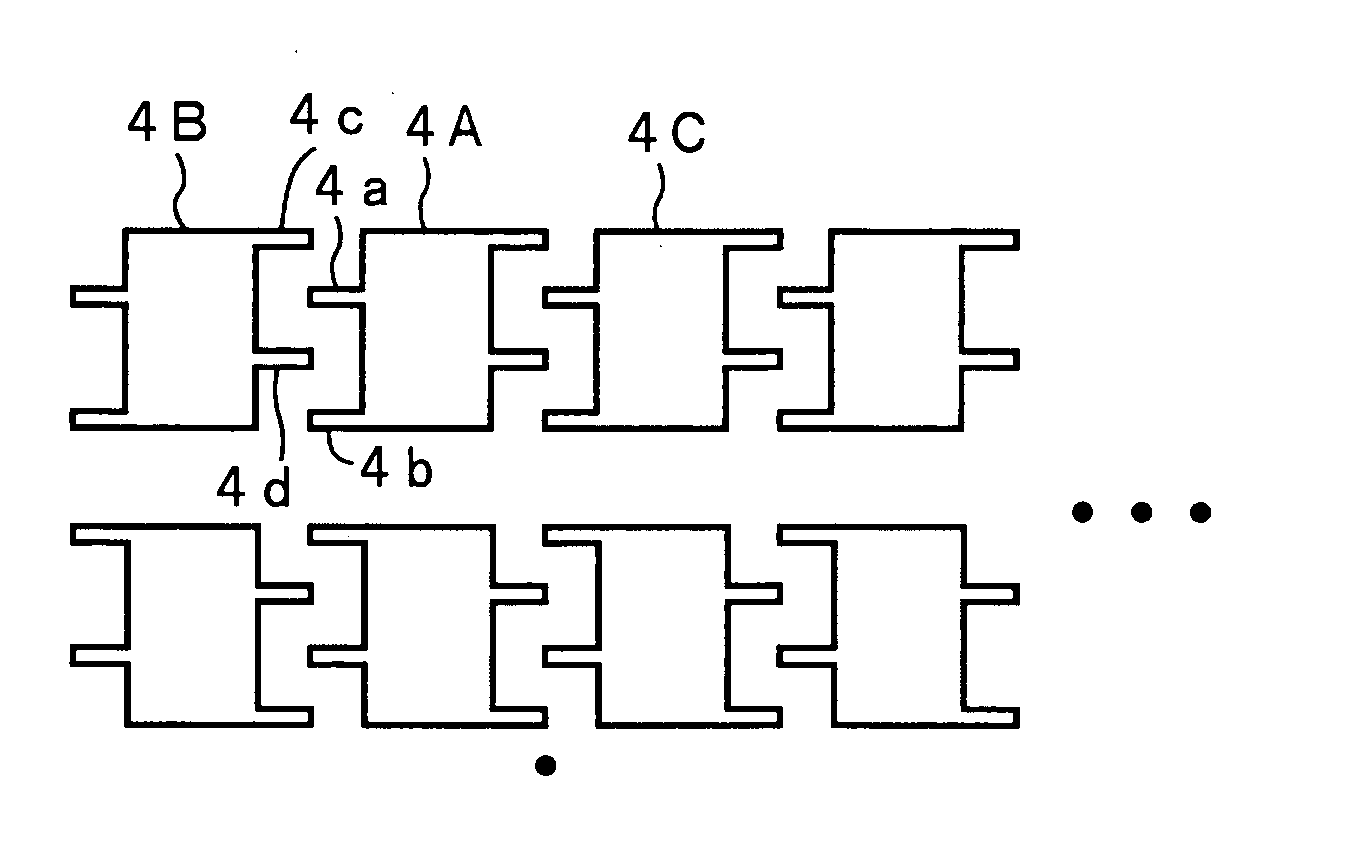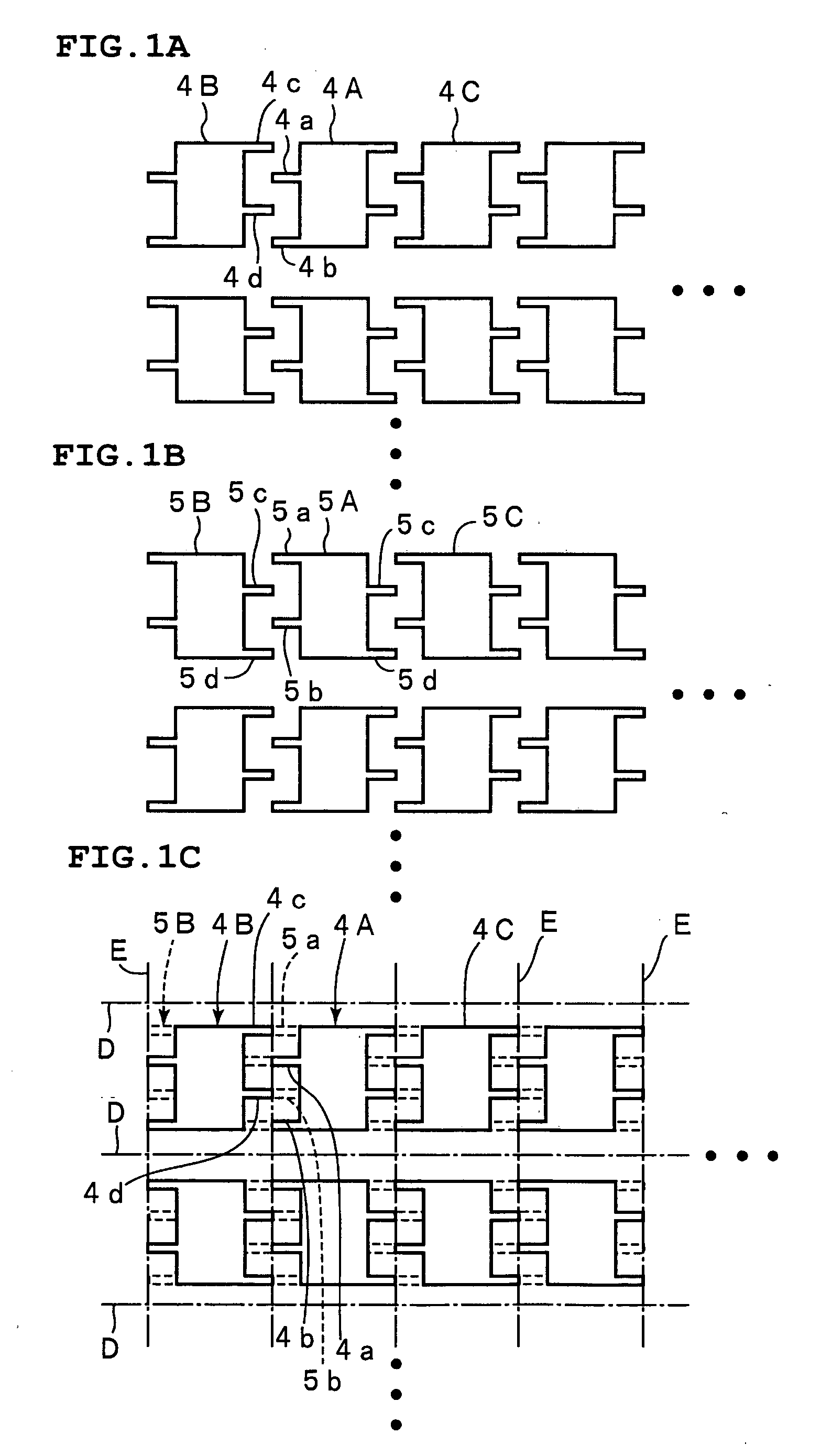Method of producing multi-terminal type laminated ceramic electronic component
a laminated ceramic electronic component and multi-terminal technology, applied in the direction of fixed capacitor details, stacked capacitors, fixed capacitors, etc., can solve the problems of unsatisfactory spread and difficulty in producing laminated ceramic electronic components having desired internal electrode patterns printed with high accuracy, and achieve high accuracy and effective enhancement of printing accuracy of internal electrode patterns
- Summary
- Abstract
- Description
- Claims
- Application Information
AI Technical Summary
Benefits of technology
Problems solved by technology
Method used
Image
Examples
first preferred embodiment
[0047]FIG. 2 is a perspective view of a multi-terminal type monolithic ceramic capacitor as a multi-terminal type laminated ceramic electronic component produced according to a first preferred embodiment of the present invention. The multi-terminal monolithic ceramic capacitor 1 includes a sintered member 2. The shape of the sintered member 2 is preferably substantially rectangular and has a first side surface 2a and a second side surface 2b opposed to each other, side surfaces 2c and 2d, an upper surface 2e and a lower surface 2f.
[0048] First terminal electrodes 3a to 3d are formed on the first surface 2a. Second terminal electrodes 3e to 3h are formed on the second side surface 2b. The terminal electrodes 3a to 3d formed on the first side surface 3a are opposed to the terminal electrodes 3e to 3h formed on the second side surface 2b via the sintered member 2.
[0049] A plurality of internal electrodes are formed inside of the sintered member 2. FIGS. 3A and 3B are schematic views ...
second preferred embodiment
[0069]FIGS. 7A and 7B are schematic plan views showing internal electrode patterns which are formed according to the production method of a second preferred embodiment of the present invention. FIG. 8 is a perspective view of a multi-terminal type monolithic ceramic capacitor which is produced according to the second preferred embodiment of the present invention.
[0070] In the multi-terminal monolithic ceramic capacitor 11, third terminal electrodes 12a and 12b are formed on a side surface 2c of the sintered member 2, and fourth terminal electrodes 12c and 12d are formed on a side surface 2d thereof, as shown in FIG. 8.
[0071] Moreover, first terminal electrodes 12e to 12i are formed on the side surface 2a of the sintered member 2, and second terminal electrodes 12j to 12n are formed on the side surface 2b thereof.
[0072] Thus, a lager number of the terminal electrodes 12e to 12j are formed on the side surface 2a, and a larger number of the terminal electrodes 12j to 12n are formed ...
third preferred embodiment
[0076]FIGS. 9A to 9C illustrate a method of producing a multi-terminal type monolithic ceramic capacitor according to a third preferred embodiment of the present invention. FIGS. 9A and 9B are plan views showing internal electrode patterns to be laminated onto the each other. FIG. 9C is a schematic plan view showing the lamination of the internal electrode patterns in the mother laminate. FIGS. 9A to 9C correspond to FIGS. 1A to 1C in the first preferred embodiment of the present invention.
[0077] One of the unique features of the third preferred embodiment lies in that the lead-out electrodes of the lengths of internal electrodes adjacent to each other are different from those of the lead-out electrodes in the first preferred embodiment of the present invention. This will be described with respect to the internal electrodes 4A and the internal electrodes 4B shown in FIG. 9A as examples. The tips of the lead-out electrodes 4a and 4b of the internal electrode 4A and the tips of the l...
PUM
| Property | Measurement | Unit |
|---|---|---|
| thickness | aaaaa | aaaaa |
| conductive | aaaaa | aaaaa |
| electric currents | aaaaa | aaaaa |
Abstract
Description
Claims
Application Information
 Login to View More
Login to View More - R&D
- Intellectual Property
- Life Sciences
- Materials
- Tech Scout
- Unparalleled Data Quality
- Higher Quality Content
- 60% Fewer Hallucinations
Browse by: Latest US Patents, China's latest patents, Technical Efficacy Thesaurus, Application Domain, Technology Topic, Popular Technical Reports.
© 2025 PatSnap. All rights reserved.Legal|Privacy policy|Modern Slavery Act Transparency Statement|Sitemap|About US| Contact US: help@patsnap.com



